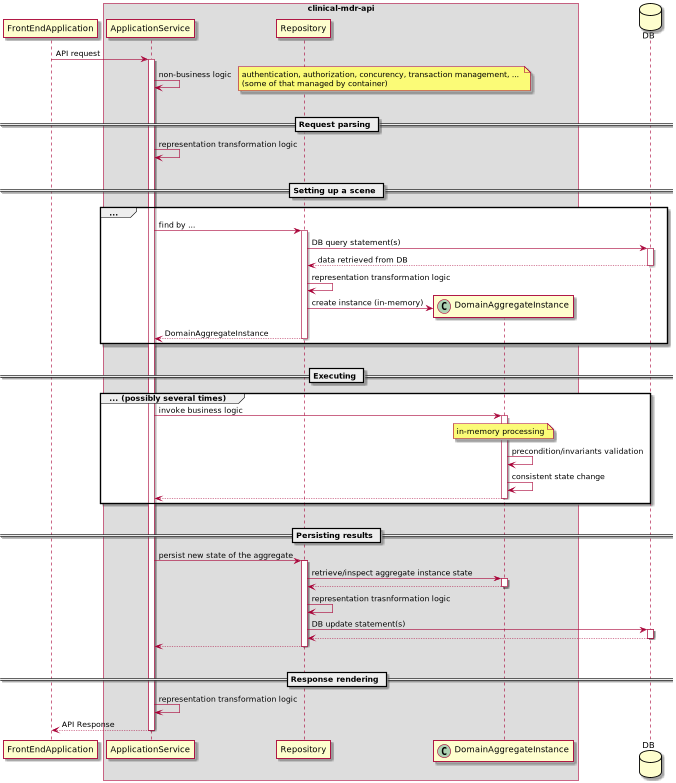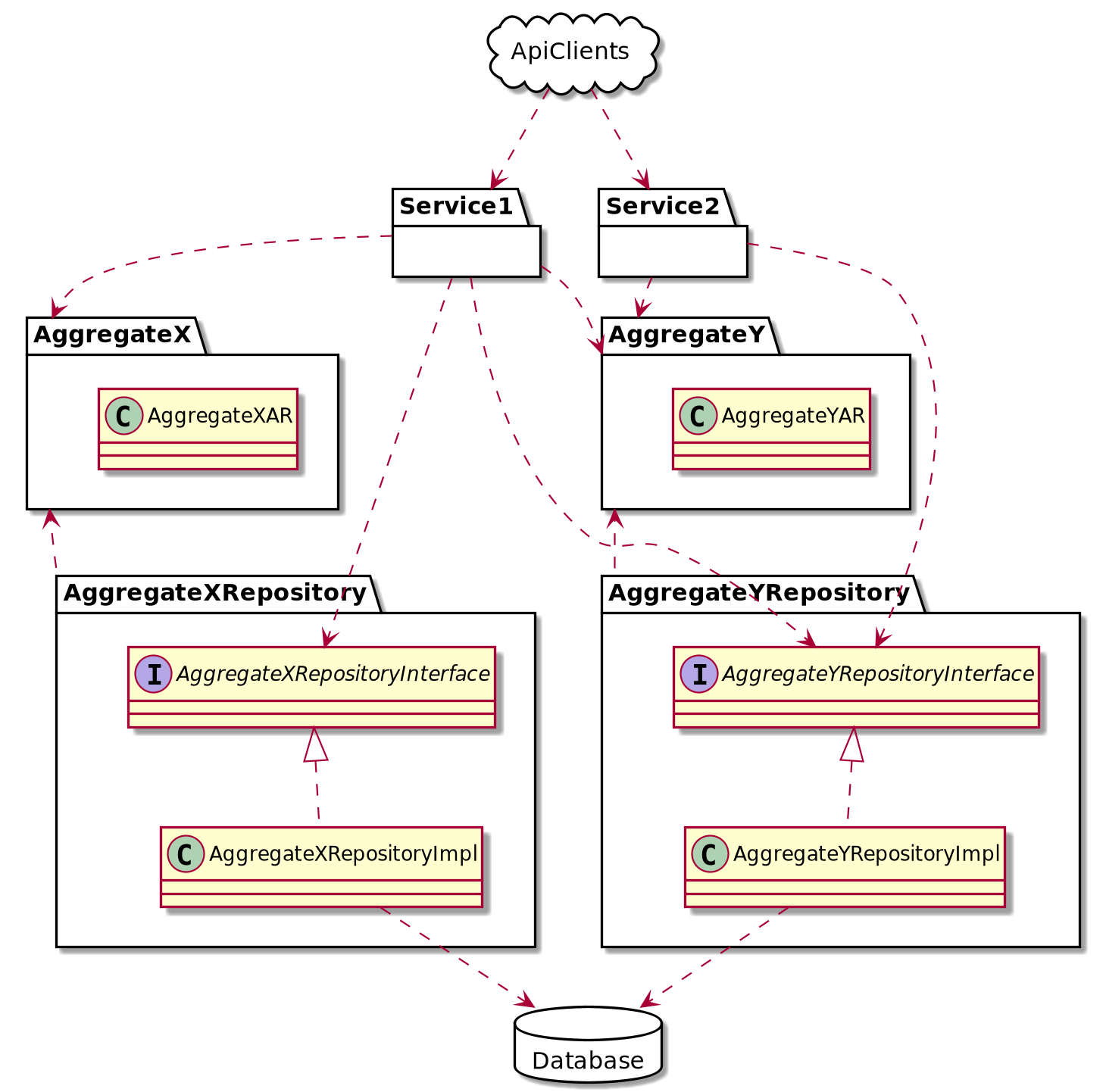# Application Architecture
This document describes the design specification for the application architecture for the OpenStudyBuilder API service layer component. This follows the Domain Driven Design pattern.
# Introduction
The purpose of this guide is to provide a clinical-mdr-api development team with some basic introduction to Domain Driven Design concepts and guidelines and practices related to DDD assumed for the clinical-mdr-api implementation project.
The content of the guide is meant to be a sort of first approximation and should be maintained and amended as applied practices and patterns evolve with the progress of the project.
# Overview of DDD approach for clinical-mdr-api
From clinical-mdr-api software design perspective the crucial implication of applying Domain Driven Design is introduction of the particular responsibility segregation pattern, which splits overall API request execution among three "layers" of code:
- domain layer (esp. its central concept - aggregate) responsible for implementation of all relevant business logic,
- one or more repositories primarily responsible for persisting and restoring objects representing domain (business) concepts (aggregate instances) to/from underlying DB (providing relevant concurrency control and transaction semantics). Repositories may also hold some responsibilities for data access/modification audit and data versioning (if required) since they provide data access for the rest of application,
- application service responsible for converting received API request content/parameters into relevant repositories and domain layer calls and their results into API responses, as well as establishing security, transaction and other relevant context for processing (which includes authentication and authorization when relevant).
Diagram below illustrates main responsibilities of above layers of code and shows the overview of collaboration between layers.
Note that given this kind of responsibility segregation there are at least three different representations of information processed by application when applying DDD approach:
- in-memory representation used by domain layer classes to execute business logic
- in-database representation used by repositories for persistent storage of domain objects instances (DB data model)
- representations used by application services to receive requests and send responses to API clients
As a design principle, it's assumed that different layers "talk" to each other using relevant public interfaces, so their specific information representation is encapsulated behind their public interfaces as well as actual implementation of operations/properties exposed by those interfaces (this principle of design is further referred as encapsulation). Applying encapsulation principle allows for lower coupling of the layers and more independent evolution of their implementation.
Note: Since there are no "real" access modifiers in Python language. We assume a convention that all names exposed by a package/module/class which do not start from leading underscore constitute a public interface of the package/module/class.
Having different representations used by the application implies a necessity to perform transformations. Given assumed scenario of interactions between layers (see diagram above) we have two kinds of transformation logic:
- transformation of API request to relevant sequence of repository and domain layer calls, and their results back to API responses which is the responsibility of application services
- transformation of state of domain objects (aggregate instances) to/from their in-database representation which is the responsibility of repositories
Note: The latter transformation may be tricky with respect to above mentioned encapsulation principle, since internal state of domain objects is not necessarily entirely exposed by their interfaces especially for manipulation. In those cases a dedicated part of a domain class public interface for interaction with repositories is designed and implemented (based on so called Memento pattern (opens new window)).
# General source code structure for DDD powered services
As noted in the above section, there are three layers of code when DDD approach is applied:
Service layer code includes four kinds of source code (which is not specific for DDD approach, more originated from applied FastAPI framework practices):
- routers located in
clinical_mdr_api/routerspackage - services located in
clinical_mdr_api/servicespackage - classes used by FastAPI framework for representation and validation of incoming/outgoing API messages
(API requests and responses) which are located in
clinical_mdr_api/modelspackage - classes used as API exceptions in
clinical_mdr_api/exceptions
Repositories code (those which follow DDD pattern) is located in clinical_mdr_api/domain_repositories.
Furthermore, a general convention is assumed to place the code defining and implementing a repository for given aggregate inside subpackage named after the aggregate (e.g. clinical_mdr_api/domain_repositories/study_definition).
Domain layer code is located in clinical_mdr_api/domain package with a general convention of creating a separate subpackage for code implementing particular aggregate (e.g. clinical_mdr_api/domain/study_definition for study definition aggregate). However, same as for repositories the latter may not be strictly followed in some special cases.
There are also some additional assumptions about dependency structure among different layers of code:
aggregate code should be independent of any other application code, including other aggregate code (however aggregates may be dependent on some modules which are reused by different aggregates)
repository code should be independent of any application code except code of the aggregate which is persisted/restored by the repository (however the looser coupling the better, and if necessary different repositories can depend on some modules which they reuse)
service layer code (for some particular service) should be independent of any other service (however different services may depend on some reusable modules)
The above dependency related principles are illustrated in the diagram below:
# General development workflow for DDD powered services
In case of implementing some new feature in the clinical MDR API (or amending/fixing existing one) in most cases a standard development workflow can be applied which consists of three phases:
- design, development and testing of relevant domain layer classes
- design, development and testing of relevant repositories (including changes in underlying DB data model if necessary)
- design, development and testing of relevant application service layer code
Given some particular case it may happen that some of those phases are not relevant (i.e. there are layers not affected) however all of them should be considered and necessary actions taken.
Assuming this particular order of work has the advantage of allowing a step by step implementation. Since domain layer is the innermost layer (i.e. independent of other layers), relevant changes in domain layer can be implemented and tested completely without need of any changes in other layers. Then after completing necessary work in domain layer one can move on to repository implementation (if relevant) and again, since it's only dependent on domain layer, the work can be completed (including testing of the repository implementation). Then finally one can move on to relevant application service code development and testing.
Note: This particular order of design and development process (especially starting from domain layer) is one of the key aspects of Domain Driven Design in context of software development process (i.e. it's the domain model that drives the design of other layers, as opposed to approach where the design of software is driven or bounded by the design of underlying DB data model).


